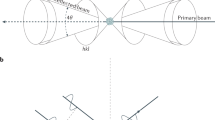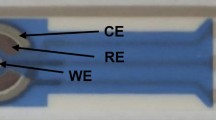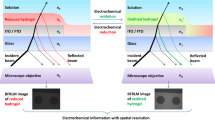Abstract
LINEAR sweep cathode-ray polarography with the dropping mercury electrode has developed in two distinct lines: single sweep polarography1–3 in which the applied potential change is impressed on the electrodes once in the lifetime of each mercury drop, and multisweep polarography4–6 in which it is applied several or many times. The latter is electronically the simpler, but the former possesses distinct advantages and is in more general use. In order to ensure that the drop surface area does not change appreciably during the electrode reaction, it is necessary, in the case of single-sweep working, to synchronize the application of the potential with the latter part of drop life. In earlier instruments this is achieved by using a multivibrator with fixed ‘rest’ and ‘sweep’ periods and arranging for the sharp decrease in current, which occurs when a drop detaches, to trigger the instrument back to its ‘rest’ condition while growth of the next mercury drop takes place. Later instruments7,8 use a more satisfactory arrangement by which the drop is detached by the application of an electromechanical pulse to the electrode capillary at the conclusion of the potential sweep.
This is a preview of subscription content, access via your institution
Access options
Subscribe to this journal
Receive 51 print issues and online access
$199.00 per year
only $3.90 per issue
Buy this article
- Purchase on Springer Link
- Instant access to full article PDF
Prices may be subject to local taxes which are calculated during checkout
Similar content being viewed by others
References
Randles, J. E. B., Trans. Faraday Soc., 44, 322, 327 (1948).
Reynolds, G. F., and Davis, H. M., Analyst, 78, 314 (1953).
Reynolds, G. F., Z. Anal. Chew., 173, 65 (1960).
Delahay, P., J. Phys. Coll. Chem., 53, 1279 (1949).
Delahay, P., and Stiehl, G. L., J. Phys. Coll Chem., 55, 570 (1951).
Delahay, P., and Perkins, G., J. Phys. Coll. Chem., 55, 1146 (1951).
Davis, H. M., and Seaborn, J. E., Proc. Second International Congress of Polarography, 1, 239 (Pergamon Press, London, 1961).
Davis, H. M., and Shalgosky, H. I., Proc. Second International Congress of Polarography, 2, 618 (Pergamon Press, London, 1961).
Powell, K. G., and Reynolds, G. F., Proc. Third International Congress of Polarography, 1964 (in the press).
Smith, G. S., Nature, 163, 290 (1949).
Howden, J. O., and Reynolds, G. F., Metallurgia, 63, 253 (1961).
Reynolds, G. F., Z. Phys. Chem. (Leipzig) (in the press).
Author information
Authors and Affiliations
Rights and permissions
About this article
Cite this article
POWELL, K., REYNOLDS, G. Cathode-ray Polarography with Rapid-dropping Mercury Electrodes. Nature 205, 695–696 (1965). https://doi.org/10.1038/205695a0
Published:
Issue Date:
DOI: https://doi.org/10.1038/205695a0
Comments
By submitting a comment you agree to abide by our Terms and Community Guidelines. If you find something abusive or that does not comply with our terms or guidelines please flag it as inappropriate.



